SONUS FABER Gravis I
Gravis means heavy and serious in Latin, and it is an aptly chosen name for a subwoofer although the Gravis I is not particulary heavy with its 15kg. Nevertheless, the Gravis I is not alone and Sonus Faber markets also bigger subs, with the range topped by 52-kilos weighing Gravis VI that makes justice to the name.
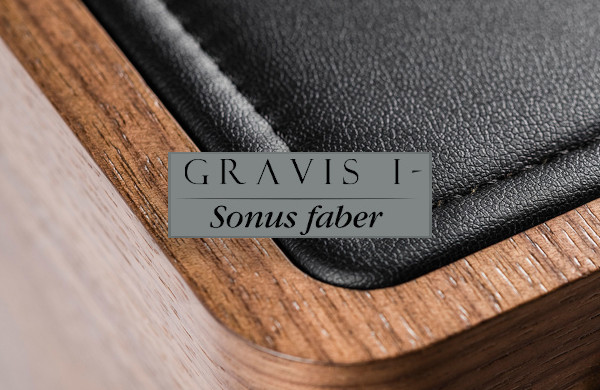
McIntosh Group, formerly Fine Sounds Group, runs its business with Sonus Faber, Audio Research, McIntosh, Sumiko and Pryma (Sonus Faber’s headphone brand). The subwoofers used to be available through Sumiko but it was decided – quite understandably - to put all the speakers under Sonus Faber. So the Sumiko subs actually have became SF’s subs, with innovated appearance and slightly modified insides.
The Gravis I is a reincarnation of Sumiko’s model S.5. Removed was the underlit logo on top, which is now clad in leather with SF’s logo embossed. Other than that and some minor cosmetics here and there the S.5’s philosophy was preserved. There is another little sub on the market, REL T/5i, that is essentially identical with the two so I guess it is one factory that makes them all.
Why to pay the attention to the Gravis I at all?
Well, it is a well thought and beautifully made subwoofer that features all those good things that are rare to find in single package:
- It has one active driver, no passive cones.
- Its cabinet is sealed, no bassreflex port.
- Its driver fires at the floor.
- It does not have Class D power supply, rather it is powered by the good old Class AB analogue amplifier.
- It does feature the High-level Input.
The things listed above do count when a subwoofer should be used in stereo but can be a disadvantage for home theater applications. And after several weeks of listening to the Sonus Faber Gravis I in my main stereo set-up - that is with the speakers that cost 80 times more than the Gravis I - I can attest that it really is a great sub for stereo. Yet there are several instances when I would discourage you from owning one:
- Do not buy it if your main speakers can play evenly down to 30Hz in the room. I doubt it as each room spoils the bass with peaks and nulls but perhaps you are the lucky one.
- Your listening room is the size of a barn or cathedral. The Gravis I is too small to pressurize big spaces.
- You do not have the patience to dial in the subwoofer properly and there is no one around to do this job for you. Blending a subwoofer seamlessly with the main speakers asks for certain skills.
- You want the Gravis I for all those post-apocalyptic movie effects.
- Don’t buy it if you miss the sub-bass and use a turntable as a main signal source. It is time to admit yourself that these frequencies are not on vinyl and let it go.
- The sub should help you study organ music. Not this one.
- You have zero freedom where to place the subwoofer in your room. Unless you are lucky you may not be able to integrate it well in the system.
I assume that any Audiodrom reader is not a novice to high end audio so I won’t spend time by explaining why passive drivers or ported designs are not the best option for stereo – it has something to do with ‘control and speed’ and I recommend you to read through the other subwoofing articles on our site (see the list at the end of this review). The interesting question, however, is whether there is any advantage to the down-firing driver.
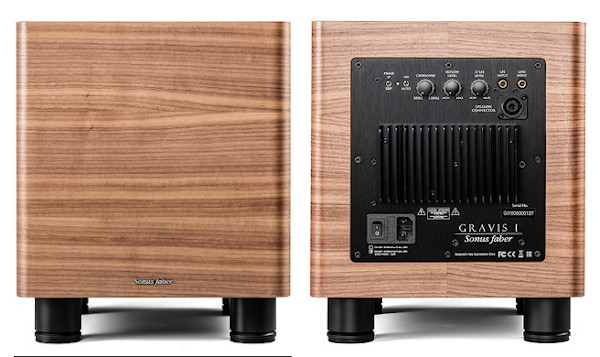
Down-firing or forward-firing?
Let me quote a real authority on subwoofers, REL Acoustics. Here is what they say:
The case for down firing requires an understanding that by firing at the floor in close proximity to that large, flat surface, we take advantage of the single largest plane in a typical house. Bass emerges from the down firing driver hits the floor and essentially crawls along the floor producing particularly deep bass. The floor couples with the driver and becomes part of the working design of the subwoofer. Furthermore, this acoustical coupling produces more output for the same amount of power. These are all free benefits, so why don’t we just build nothing but down firing subwoofers? There’s more to making state of the art bass though than just raw output and more than simply how deep the bass goes, although both of those are prime directives for our engineering team. Speed, clarity, precise intonation of individual tones, air and the way compressed air masses strike one’s body (think of the kick drum in a modern traps set), decay patterns being correctly reproduced all play pivotal roles in truly special systems.
These characteristics are where fast, lightweight, direct-firing drivers come into play. Forward-firing drivers produce all of the characteristics listed above far better than down firing drivers and can result in bass that sounds fast and airy while at the same time highly impactful – a characteristic that is blunted in down firing designs. Kick drums, explosive effects in movies, gunfire, delicate shimmering infra bass as produced by pipe organs; all these benefit from exceptionally fast, forward-firing designs.
All the above is true, I would only put it in the right context. If complementing bass-shy monitors is your mission then you need a subwoofer that will perform great up to 60-80Hz or even beyond. Such a sub will be actually an outboard bass/midbass unit, a missing bass driver of your monitors, so it should be performing at least at the level of your speakers. However, if you already have good full-range speakers and your mission is to add fullness and energy to music by filling in the nulls in the 30-50Hz area, then all you ask from the sub is perfect and seamless integration. The goal is not to add the bass, rather enhance it. And the Sonus Faber Gravis I worked like a miracle.
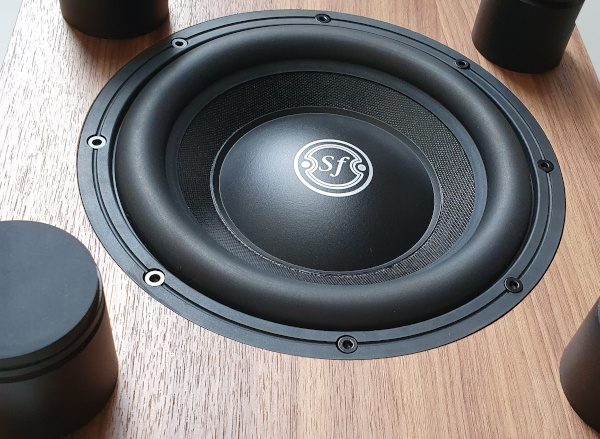
Not your usual subwoofer track
Wayfaring Stranger (Johnny Cash, III Solitary Man, American) is a stunning little piece that features undulating acoustic instrumentation, Mr. Cash’s deep baritone reciting not less deep lyrics, Laura Cash on fiddle, and, behold, Sheryl Crow on accordion. The sound is very spacious with each instrument firmly locked in its position, both vocals and instrumental lines are palpable and three-dimensional, real bodies not just sounds. That’s what I heard with the Gravis I. It is time to switch it off now.
With the Gravis I in the OFF mode the presence increases. The instruments and the vocal move slightly forward, they sound as if extracted from the background canvas. The Cash’s voice loses a tad of its sonority and now it sounds like a recorded voice rather than ‘a voice on the room’. The instrumental colours fade a tiny bit and their harmonic envelope shifts towards transients. I can hear each lick of a string, each resonance of the bow, yet all those micro-sounds as if compete with each other and the music loses its natural flow. Everything is less relaxed and more pushed to my ears, sounding more ‘electric’ which is not a good thing for the fiddle and the accordion, is it? The 3D soundstage is still there but less palpable, less engaging. The most affected is the depth that shrinks into a much flatter plane right behind the speakers.
By all means the Wayfaring Stranger is not a track that anyone would use to test a subwoofer. Nevertheless I find the magnitude of change with the Gravis I included intriguing. Another important thing that I would like to highlight is that the Gravis I’s settings were very conservative.
Resist the temptation
The ‘conservative’ can mean different things to different people. To me the proper dial-in of the subwoofer means that I no way know that it plays until I switch it off. I use to read posts on internet forums that claim it is impossible to supplement a high end stereo set-up with a sub. All the subs that I had reviewed during last 10 years blended with my main speakers without any issue; it is important to resist the temptation, be disciplined and stay on the conservative side whenever a decision about the settings is made. Usually any setting that I initially accept as ‘optimum’ is evaluated a few days later as ‘too hot’. And most automated dial-in routines – with some honorable exceptions – are a disaster. So the best advice I can give is don’t be impatient and spend enough time with your new sub.
With the Sonus Faber Gravis I my conservative settings were as follows: The high pass filter (the cross-over) at roughly 45Hz (it may have been almost 50Hz as well for it is difficult to identify exact frequency point at the Gravis – unfortunately the control knobs have no numbers next to marks). The volume was turned to about 20% and this was enough for the sub to kick in exactly the way I liked it.
The Gravis I was completely invisible in my system and I had no chance whatsoever to locate it in the room with my eyes closed, which I did to a certain extent with any other sub I had before. I guess this amazing level of integration owes to the three-pole Neutrik Speakon High Level Input that couples the Gravis I directly to the amplifier’s speaker terminals.
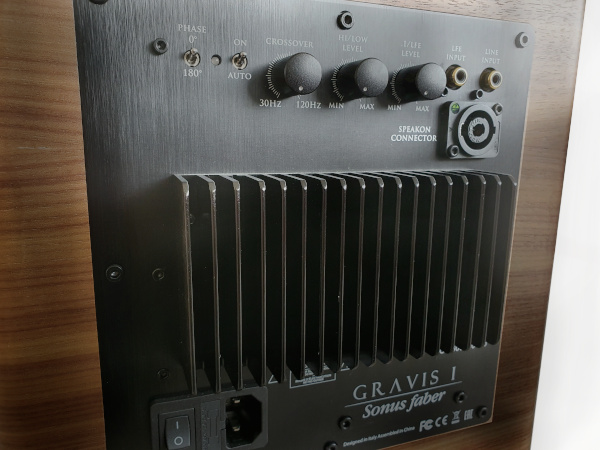
What exactly is the High Level Input?
At the dawn of subwoofers the signal was usually taken from the speaker’s binding posts, however, the subs were almost exclusively of passive design. The high level connection for active subwoofers, which actually means taking the output signal from the main amplifier’s speaker posts, was pioneered by REL Acoustics.
The reasoning behind connecting the sub to the same place where you main speakers are connected is simple: this is the only way to make sure that all the drivers that are a part of the playback chain are feed identical signal. Usually it is the power stage of the amplifier that gives us the sound that we want, that is why we experiment with solid-state, tubes, and Class D amps of different brands. Once the output signal is taken from the preamplifier (low level connection via XLR or RCA) then the main amplifier is actually by-passed, so you will miss, for example, the warmth and transparency of your valve amp or the control and precision of your solid-state powerhouse. By using the High Level Input the subwoofer receives exactly the same signal like the main speakers, including its flavor. For ear, consequently, it is impossible to distinguish between the two, which is not the case for RCA/XLR/LFE where you may end up with two or more (if you use 5.1 for example) different sound flavors that are hard to blend.
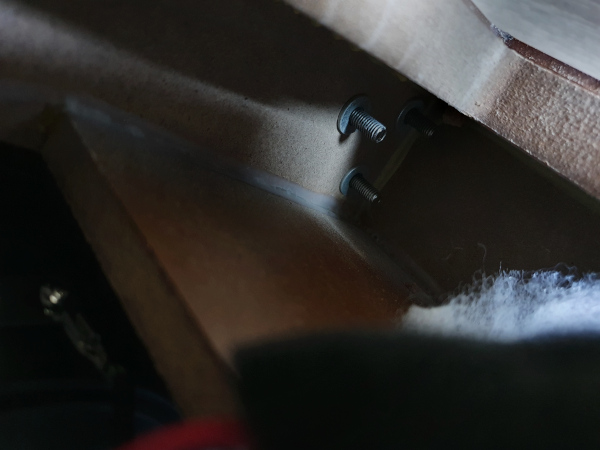
The bass the Gravis-style
Blade Runner 2049 (Hans Zimmer and Benjamin Wallfisch) is the soundtrack for validation of any subwoofer’s competencies. The subterranean bass is the essential part of this score that induces a sense of a distant earthquake. Now, the Gravis I does not provide deeper bass notes than my resident TAD Evolution One speakers and I did not expect any benefit from adding it therefore. As I explained earlier the difference was remarkable, however, not in quantity but in quality. The TAD’s dual bass drivers, although better than the one in the Gravis I work into a bigger ported cabinet, and fire forward at sofa height. The driver in the Sonus Faber is quite agile in its closed cabinet and uses the floor to a great benefit. The symbiosis of the main speakers and the subwoofer could not be better – the weight was preserved, the definition and palpability was improved. The sound became more enveloping, energetic and penetrating, and much smoother and tuneful at the same time.
I have been hearing Cobalt 60 and the Dolphin track (Twelve, Edel) in my head since almost ten years ago – that’s when I heard it through the Ante Supersonic One speakers, the speakers with internal volume of a small car. Now, with the Gravis I, I got the same feeling minus the sheer mass that the Ante excited back then. The pulsating bass line of the Dolphin was like relentless punches in my stomach, full and impactful.
On Mahler (Symphony #2, Osmo Vänskä) the Gravis I made the symphonic orchestra spread wide and deep behind the speakers, plus it smoothened the bass response below 50Hz, and nicely balanced the upper tilt of the TAD’s extremely clean concentric driver to arrive to hilarious instrumental colours.
Love Over Gold (Dire Straits, Mobile Fidelity Ultradisc DSD SACD) is a remaster based on 30ips tapes on a Studer deck. The MoFi version bet on overall clarity and bass restoration which it succeeded at. It is pity that the typical 80s hot highs were not turned down a bit in the remastering process – the version is like made by a Tinkerbell. The Sonus Faber Gravis I has nothing to do with highs but by adding fullness at the bottom helps shifting the record’s gravity center lower towards much better frequency balance. The first minute of Private Investigations was simply stunning.
Also Joe Beard’s For Real SACD has its origins in 30ips tapes on Studer deck. This AudioQuest recording issued on Sledgehammer Blues label is underproduced comparing to the MoFi’s Dire Straits, yet it is more authentic and raw. Through its understated presence the Gravis I adds juiciness to much tastier listening pleasure.
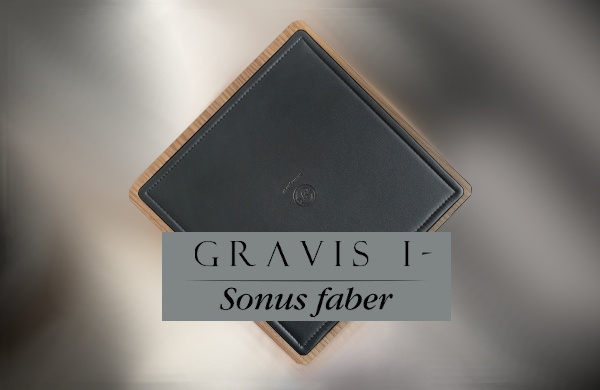
David or Goliath?
The Gravis I’s 8” (21cm) long-throw paper cone is driven by a 150 Watt Class AB amplifier. On paper its peak power is max 250W, a value that is low vis-à-vis megawatts of modern switching power supply active designs. The Gravis I’s amplifier also runs quite hot and the heat is dispersed through the fins and the whole back plate. This is means wasting energy, who would want such a subwoofer in the green age?
True, the power output of the Sonus Faber is quite modest for home cinema energy bursts as is for all but smaller rooms. Once the volume control is turned beyond 12 o’clock value (50%) the driver starts to be noisy, but if you do not push the Gravis I hard it is self-assured and tuneful. The small disadvantage, common to the Class AB amps, is that in the absolute silence of the room the sub softly purrs.
Why have I kept the Gravis I then? Yes, this sub does not leave my listening room. Because, unlike the digital subs, the Gravis I did not induce any HF interference in my system with all its negative effects. There were few subs like sizeable REL, Bowers & Wilkins, Velodyne and SVS that were properly shielded and interference free, yet these boxes were way too big and an overkill for what I wanted them to do down below 40Hz. The Sonus Faber Gravis I is small, neat and a fantastic performer. Who would suspect the real high-end to come in such an understated form?
Price at the time of the review: 21.900 Kč
Contact: EP Audio, Praha, tel. +420 323 605 088
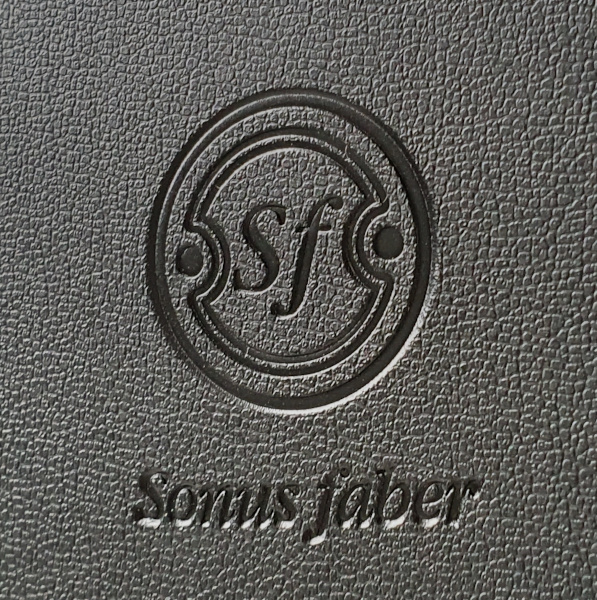
Other recommended reading:



